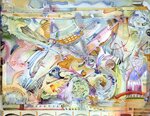
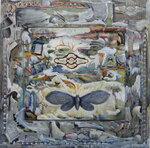


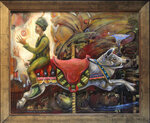
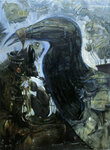
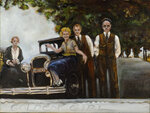

When Lambertville, N.J., artist Annelies van Dommelen works in her studio, she’s like a kid walking into F.A.O. Schwarz.
Her latest amusement is a gelli plate. She rolls a thin coat of acrylic onto the plate, lays down a high-contrast image cut from a magazine or her own drawings and then pulls up that paper image, leaving a version of it on the gelli plate.
Annelies then lays paper over it and the gelli plate releases the image left on the plate, transferring the image to the paper. The resulting image, which often doesn’t come out perfectly, she says, serves as the beginning or the suggestion of an image for many of her acrylic paintings, or perhaps a future collage element.
“This has opened up my world in a way you can’t imagine,” says Annelies. “I watched a lot of YouTubes to learn gelli printing techniques. It’s nonending fun.”
Amidst the fun, she completes the selection of approximately 50 works dating back to 1979 for her New Hope Arts retrospective exhibition, “Unstill Life,” running Feb. 17-March 10.
Looking back at 50 years of studying and creating art has shown her that “I wasn’t as bad as I thought,” Annelies quips. Early on she was in command of her visual expression. “I always had my own style, but I had to come to terms with it. That was the issue. I had to accept my own style as being relative, as opposed to being like everyone else or doing what was expected of me.”
That sense of identity developed in her childhood, when Annelies, the daughter of Dutch immigrants, roamed her “backyard” — Washington Crossing State Park, where her home was since her father was chief forester. Explorations of nature fueled her imagination; inspired by her mother’s aesthetic of form and beauty, Annelies had an innate sense of balance.
“Balance is a feeling for me,” she says. “It’s more about controlling the eye, attracting the viewer to come forward and look at the detail, because I’m extremely detail-oriented. Even in large paintings, every single brush stroke I put down has thought behind it. It’s just the way I am. I’ll know when something’s out of balance for sure.”
Annelies’s self-awareness has come from a lifetime of curiosity and discovery. The exhibition will reflect the multitude of mediums she has explored in painting, print-making, and paper-making. She’s painted abstract watercolors “since the beginning of time.”
“I call them ‘soft machines’ because I didn’t have any particular idea in mind…It’s just pure motion, energy, abstraction with some point of view with many layers of color.”
Abstract art, in the form of large paper constructions, was a commercial success when she was represented at Philadelphia’s prestigious Rosenfeld Gallery.
“I didn’t have to censor myself, I just did what I did and corporations bought it. Sometimes I’d hear of a vertical [work of mine] put on its horizontal, which was fine with me. A lot of my work, if it’s abstract, I’ll turn it in different ways, because that’s a true test of how an abstract works all the way around, it should be well-balanced.”
A small paper genre, dioramas, will be included in the exhibition. Annelies makes one diorama, including the box itself, every couple of years from all sorts of collected materials.
Natural lighting in her newly-built studio helps Annelies cast a fresh eye on her work: some etchings from the ’80s have recently been reprinted. Annelies thought she had finished the oil painting, “Destiny,” 20 years ago, but actually revised it just five years ago.
Some of her other large oil paintings, rarely or never shown, “are closely related to my life in more symbolic ways.” For example, Annelies painted “Hostage” after completing breast cancer treatment 30 years ago. Her “Neverfade” series, paintings of her and her parents, are derived from old photos printed on Kodak neverfade paper.
Studying at the Pennsylvania Academy of the Fine Arts, Annelies experienced immediate success with stone lithography. “I got it — the drawing on the stone, black and white is a strong point of mine because you don’t have to think about color. It’s more about drawing on the stone, it’s a touch you never have with any other medium.” Most of the works in the exhibition will be for sale, except for some of the lithographs, such as “Storm,” since they’re Annelies’s last copy.
The complexity of her work is astounding, replete with natural and fantastical imagery. The corvid, or crow, is her mascot, since she rescued an injured one when she was 10 by carrying it a quarter-mile to the nature center. It’s there not because of the artists’ maxim, “put a bird on it and it will sell.”
Annelies’s humans sometimes appear like mannequins, without facial features or genitalia. Despite having drawn countless anatomically correct figures in classes, she “didn’t want to give them an identity. They were meant to represent human-kind.” Yet a painting like “Anthology” is a self-portrait, of how the artist would like her image to be.
What will Annelies’s retrospective represent?
“When I was going through my old work, I saw that I was very hard on myself during the process of doing it, which is a natural evolution to learning how to make artwork in general. You can recognize that this is how you’ve grown, this is how you’ve spent your life. At the age of 72, thinking back, I’m glad I’ve spent my life this way. I made it work somehow, I have no idea how.” She laughs. “It’s totally amazing to me.”
The opening reception for “Unstill Life” will take place from 6-9 p.m. Feb. 17, at New Hope Arts, 2 Stockton Ave., New Hope. The retrospective exhibition continues through March 10. For information, go to www.newhopearts.org.
Join our readers whose generous donations are making it possible for you to read our news coverage. Help keep local journalism alive and our community strong. Donate today.